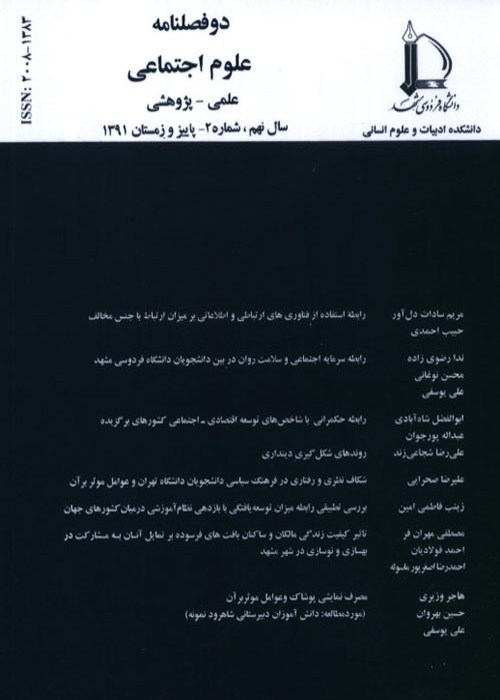The Comprehension of Femininity in Private and Public Realms by 3 to 6-Year-Old Children in Mashhad
Author(s):
Article Type:
Research/Original Article (دارای رتبه معتبر)
Abstract:
1. Introduction
Femininity refers to an identity imposing a set of rules on females. When children become aware of their sexual identity as a male or female, they need to acquire the requisites of this role in order to complete their identity. In other words, they figure out that they should learn about the definitions and parameters of femininity and masculinity to accomplish their gender role.These definitions affect the way people function in different situations of life. Therefore, addressing women's roles in the family and society is a way of understanding the definition of femininity, since femininity is an image that is realized in individuals' roles. It is important to note that the literature has given little attention to this concept from the children's perspective.The patterns of male and female roles are not universal; in this regard, femininity and masculinity vary according to each culture. As such, the conceptualization of feminine and masculine concepts from a child's perspective would facilitate the comprehension of social structures and bring about the possibility of modifying these structures. The adoption of a qualitative and phenomenological approach is also a facilitative way toward obtaining a richer understanding of the concept of femininity. In the literature, little attention has been given to individuals' thoughts, feelings, and knowledge about belonging to a particular gender group or femininity and masculinity.
2. Theoretical Framework
Gender is a concept describing the cultural meanings assigned to each of the social classes of males and females. When individuals integrate these cultural meanings into their mental state, gender becomes part of their identity. Individuals perceive their gender identity based on the cultural meanings of femininity and masculinity. Thereafter, they think and act in accordance with their given gender role. These cultural meanings of gender show themselves as gender schemas. Gender schemas provide a framework to define gender for a person and to act accordingly. Sandra Bem believes that the child has an active role in the development of the concept of gender. The child comes to mental associations based on the gender through social interactions.According to different studies conducted in various cultures, femininity can be primarily defined at the public and private domains. This concept is largely affected by the sociological perspective regarding the issue of women and capitalist system. The public domain related to femininity determines the social roles, such as occupation and education, while the private domain considers the family and household environment rather than social activities.
3. Method
This study was conducted on 83 children (i.e., 43 females and 40 males) within the age range of 3-6 selected from 12 kindergartens of Mashhad, Iran, using a qualitative approach and an interpretive phenomenological analysis. Phenomenological investigation reveals the meaning of the lived experiences of individuals with regard to a concept or phenomenon and emphasizes the participants' shared experience of that phenomenon.Phenomenology is not only a description, but also an interpretative process in which the researcher interprets the meaning of lived experiences. The study population was selected using purposive sampling method, combining maximum variation and homogeneous sampling techniques. The main research instrument was a semi-structured interview entailing painting, ready-made images, games, and e-book fitting the children's knowledge, competence, interest, and the place they live in. The data were analyzed using the method put forward by Dickelman et al. (as cited in Abedi, 2010).
4. Results and Discussion
In the present study, the woman was described as someone who functions at home and cooks for the family; she deals with housework, such as cleaning, dishwashing, vacuum cleaning, and doing the laundry, in addition to caring for, feeding, and playing with children. She pays attention to the needs of others and, if someone gets sick, she takes care of him/her. For this woman, children and home affairs are always important. In the eyes of the children, the social status of the women is described as follows: when the woman leaves the house for work, she usually goes to school and teaches or works as a doctor or a nurse at a hospital. The children assume that females cannot perform many jobs such as firefighting, butchery, presidential roles, managing, police service, and being a pilot. Furthermore, girls' games, the kind of the toys they chose to play with (e.g., dolls, kitchen utensils, and cosmetics), the kind of the games they opted for (e.g., playing a grown up to take the role of a mother with who is cooking and caring for other or playing the role of a teacher or a doctor), and their wishes to be teachers, mothers, or nurses in the future, are all in line with the activities defined as feminine in adulthood.Children express reasons for their answers. They connect specific attributes to each gender by observing the environment, receiving environmental messages, and conforming to the femininity recommended at home, kindergarten, and community. Some of the attributes assigned to females included caregiving, cowardice, and disability in financial, physical, cognitive, and functional fields. This caregiving was especially observed at home and in relation to people in need of attention and care.In the same vein, regarding the workplace, the types of occupation attributed to women (e.g., teacher, nurse, and doctor) can be considered as activities entailing caring for children and people who are injured and in need of help. In the eyes of children, fear and disability of women are associated with the out-of-home tasks and the activities that require high courage, intelligence, strength, money, and safety. Although women are capable of caring for others, they fail to adequately protect themselves and their surrounding environment and cannot control and manage situations.
5. Conclusion
The feminine image in the current culture depicts the female as a caring entity in the private sphere and an incapable being in the public domain. This image of female is one that has been challenged by biological, psychological, sociological, political, philosophical, and especially feminist perspectives from the past to the present with little if any changes. The scientists have tried to give an explanation for this image. The image ultimately constitutes the patterns of communication between the two genders.Keywords:
Language:
Persian
Published:
Journal of Social Sciences, Volume:15 Issue: 2, 2019
Pages:
305 to 343
magiran.com/p2019735
دانلود و مطالعه متن این مقاله با یکی از روشهای زیر امکان پذیر است:
اشتراک شخصی
با عضویت و پرداخت آنلاین حق اشتراک یکساله به مبلغ 1,390,000ريال میتوانید 70 عنوان مطلب دانلود کنید!
اشتراک سازمانی
به کتابخانه دانشگاه یا محل کار خود پیشنهاد کنید تا اشتراک سازمانی این پایگاه را برای دسترسی نامحدود همه کاربران به متن مطالب تهیه نمایند!
توجه!
- حق عضویت دریافتی صرف حمایت از نشریات عضو و نگهداری، تکمیل و توسعه مگیران میشود.
- پرداخت حق اشتراک و دانلود مقالات اجازه بازنشر آن در سایر رسانههای چاپی و دیجیتال را به کاربر نمیدهد.
In order to view content subscription is required
Personal subscription
Subscribe magiran.com for 70 € euros via PayPal and download 70 articles during a year.
Organization subscription
Please contact us to subscribe your university or library for unlimited access!



